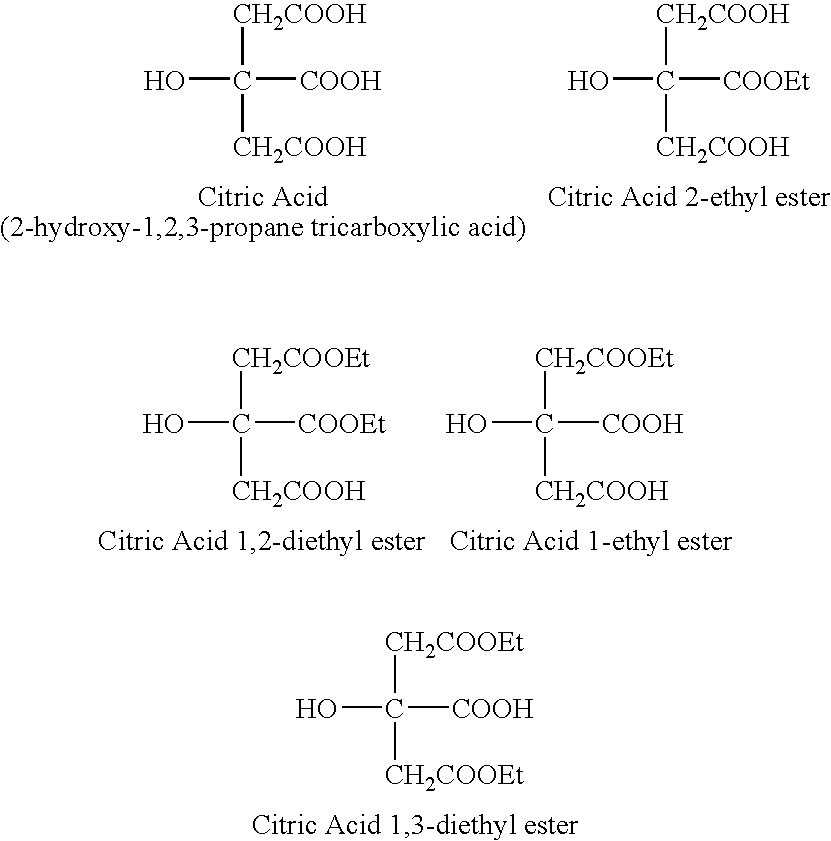[0049]A
hydrotrope is a compound that has an ability to enhance the water
solubility of other compounds. A
hydrotrope utilized in the present invention lacks surfactant properties, and typically is a short-chain
alkyl aryl sulfonate. Specific examples of hydrotropes include, but are not limited to,
sodium cumene sulfonate,
ammonium cumene sulfonate,
ammonium xylene sulfonate,
potassium toluene sulfonate,
sodium toluene sulfonate,
sodium xylene sulfonate,
toluene sulfonic acid, and
xylene sulfonic acid. Other useful hydrotropes include sodium polynaphthalene sulfonate,
sodium polystyrene sulfonate, sodium methyl
naphthalene sulfonate, sodium
camphor sulfonate, and
disodium succinate. A
hydrotrope, if present at all, is present in an amount of about 0.1% to about 30%, and preferably about 1% to about 20%, by weight of the composition. To achieve the full
advantage of the present invention, a composition can contain about 2% to about 15%, by weight, of a hydrotrope.
[0050]The term “polyhydric
solvent” as used herein is a water-soluble
organic compound containing two to six, and typically two or three, hydroxyl groups. The term “water-soluble” means that the polyhydric
solvent has a water
solubility of at least 0.1 g of polyhydric
solvent per 100 g of water at 25° C. There is no upper limit to the water
solubility of the polyhydric solvent, e.g., the polyhydric solvent and water can be soluble in all proportions. The term polyhydric solvent, therefore, encompasses water-soluble diols, triols, and polyols. Specific examples of hydric solvents include, but are not limited to,
ethylene glycol,
propylene glycol,
glycerol,
diethylene glycol,
dipropylene glycol,
tripropylene glycol,
hexylene glycol, butylene glycol, 1,2,6-hexanetriol,
sorbitol, PEG-4, and similar polyhydroxy compounds. A polyhydric solvent, if present at all, is present in an amount of about 0.1% to about 30%, and preferably about 5% to about 30%, by weight of the composition. More preferably, the polyhydric solvent is present in an amount of about 10% to about 30% by weight of the composition. In contrast to a disinfecting alcohol, a polyhydric solvent contributes minimally, if at all, to the
antimicrobial efficacy of the present composition.
[0051]Other specific classes of optional ingredients include inorganic phosphates, sulfates, and carbonates as buffering agents; EDTA and phosphates as chelating agents; and acids and bases as pH adjusters. Examples of preferred classes of optional basic pH adjusters are
ammonia; mono-, di-, and tri-
alkyl amines; mono-, di-, and tri-alkanolamines;
alkali metal and
alkaline earth metal hydroxides; and mixtures thereof. However, the identity of the basic pH adjuster is not limited, and any basic pH adjuster known in the art can be used. Specific, nonlimiting examples of basic pH adjusters are
ammonia; sodium,
potassium, and
lithium hydroxide; monoethanolamine;
triethylamine; isopropanolamine;
diethanolamine; and
triethanolamine. Examples of preferred classes of optional acidic pH adjusters are the mineral acids. Nonlimiting examples of mineral acids are
hydrochloric acid,
nitric acid,
phosphoric acid, and
sulfuric acid. The identity of the acidic pH adjuster is not limited and any acidic pH adjuster known in the art, alone or in combination, can be used. An optional alkanolamide to provide composition thickening can be, but is not limited to,
cocamide MEA,
cocamide DEA, soyamide DEA, lauramide DEA,
oleamide MIPA, stearamide MEA, myristamide MEA, lauramide MEA, capramide DEA, ricinoleamide DEA, myristamide DEA, stearamide DEA, oleylamide DEA, tallowamide DEA, lauramide MIPA, tallowamide MEA, isostearamide DEA, isostearamide MEA, and mixtures thereof. Alkanolamides are noncleansing surfactants and are added, if at all, in small amounts to thicken the composition.
[0052]The present antimicrobial compositions also can contain about 0.01% to about 5%, by weight, and preferably 0.10% to about 3%, by weight, of an optional gelling agent. More preferably, the antimicrobial compositions contain about 0.25% to about 2.5%, by weight, of a gelling agent. The antimicrobial compositions can contain a sufficient amount of gelling agent such that the composition is a
viscous liquid, gel, or semisolid that can be easily applied to, and rubbed on, the
skin or other surface.
[0053]The term “gelling agent” as used here and hereafter refers to a compound capable of increasing the
viscosity of a water-based composition, or capable of converting a water-based composition to a gel or semisolid. The gelling agent, therefore, can be organic in nature, for example, a
natural gum or a
synthetic polymer, or can be inorganic in nature.
[0054]The following are nonlimiting examples of gelling agents that can be used in the antimicrobial compositions contemplated herein. In particular, the following compounds, both organic and inorganic, act primarily by thickening or gelling the aqueous portion of the composition:
acacia,
agar, algin,
alginic acid,
ammonium alginate,
ammonium chloride,
ammonium sulfate,
amylopectin, attapulgite,
bentonite, C9-15 alcohols,
calcium acetate,
calcium alginate,
calcium carrageenan, calcium
chloride, caprylic alcohol, carboxymethyl hydroxyethylcellulose, carboxymethyl
hydroxypropyl guar,
carrageenan,
cellulose,
cellulose gum, cetearyl alcohol,
cetyl alcohol,
corn starch, damar,
dextrin, dibenzylidine
sorbitol,
ethylene dihydrogenated tallowamide,
ethylene dioleamide,
ethylene distearamide,
gelatin,
guar gum,
guar hydroxypropyltrimonium
chloride,
hectorite,
hyaluronic acid,
hydrated silica, hydroxybutyl methylcellulose, hydroxyethylcellulose, hydroxyethyl ethylcellulose, hydroxyethyl stearamide-MIPA, hydroxypropylcellulose,
hydroxypropyl guar, hydroxypropyl methylcellulose, isocetyl alcohol,
isostearyl alcohol,
karaya gum,
kelp,
lauryl alcohol,
locust bean gum,
magnesium aluminum silicate,
magnesium silicate,
magnesium trisilicate, methoxy PEG-22 / dodecyl glycol
copolymer, methylcellulose,
microcrystalline cellulose,
montmorillonite, myristyl alcohol, oat flour, ° leyl alcohol,
palm kernel alcohol,
pectin, PEG-2M, PEG-5M,
polyvinyl alcohol,
potassium alginate, potassium
carrageenan, potassium
chloride,
potassium sulfate,
potato starch,
propylene glycol alginate, sodium carboxymethyl
dextran, sodium carrageenan, sodium
cellulose sulfate, sodium chloride,
sodium silicoaluminate,
sodium sulfate, stearalkonium
bentonite, stearalkonium
hectorite,
stearyl alcohol,
tallow alcohol, TEA-
hydrochloride,
tragacanth gum,
tridecyl alcohol,
tromethamine magnesium
aluminum silicate,
wheat flour,
wheat starch,
xanthan gum, and mixtures thereof.
 Login to View More
Login to View More 
